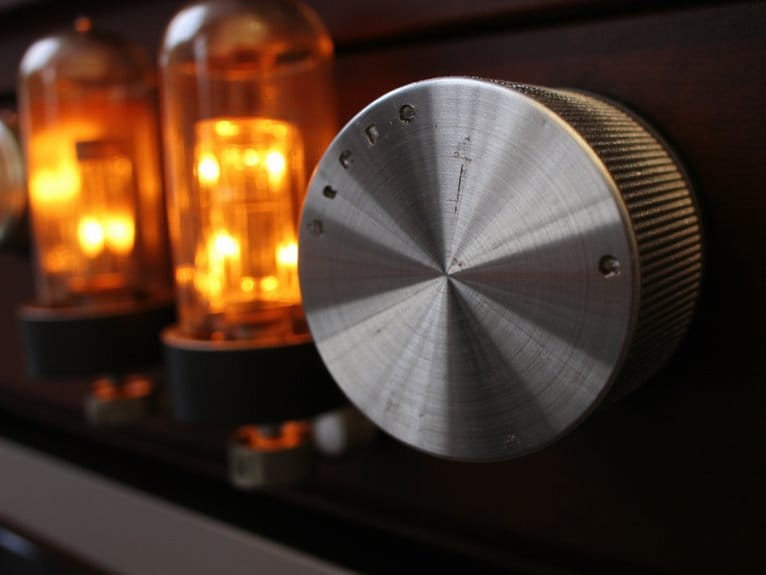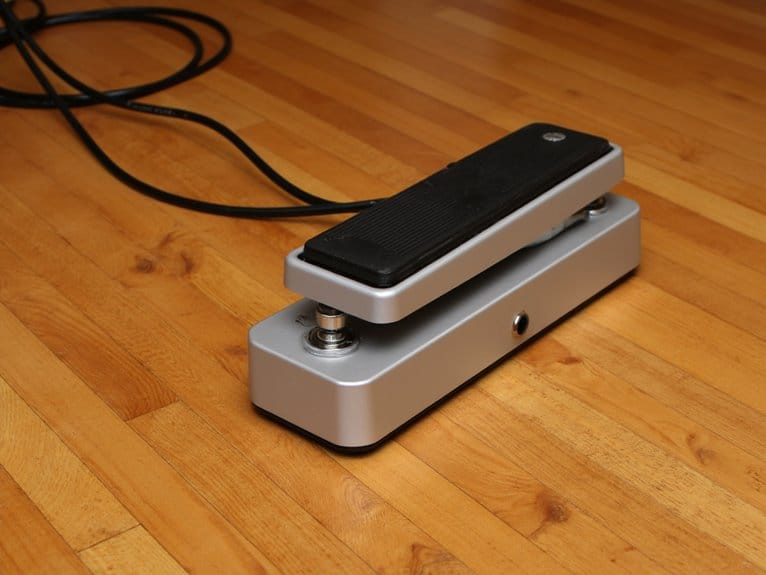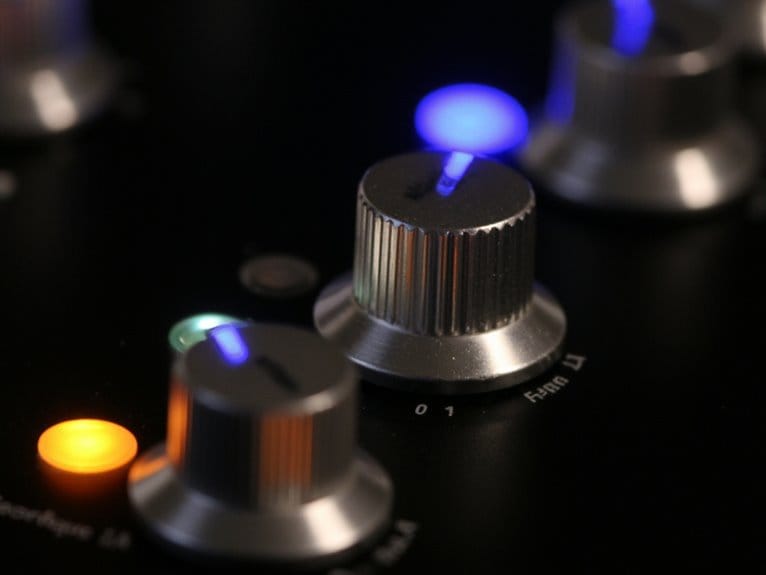Understanding Bass Guitar Scale Length and Its Effects
Your bass guitar’s scale length—the distance from nut to bridge—fundamentally determines string tension, playability, and tonal character. Short scales (30-32 inches) offer warmer tones and easier fretting, while standard long scales (34+ inches) provide brighter, more defined sounds with higher tension. This measurement affects everything from fret spacing comfort to sustain characteristics, with medium scales (32-34 inches) balancing both extremes. Understanding these differences helps you choose instruments that match your playing style, and there’s much more to evaluate about string selection and technique implications.
We are supported by our audience. When you purchase through links on our site, we may earn an affiliate commission, at no extra cost for you. Learn more.
Notable Insights
- Scale length is the distance from nut to bridge, affecting string tension, tone, and playability across the instrument.
- Short scales (30-32″) produce warmer tones with easier playability, while long scales (34″+) create brighter, more defined sounds.
- Longer scale lengths require higher string tension for proper pitch, affecting finger force needed and overall playing comfort.
- The standard 34″ scale length established by Leo Fender provides versatile balance between tone quality and playability characteristics.
- Scale length influences fret spacing and sustain, with shorter scales offering closer frets but longer scales providing better clarity.
What Is Bass Guitar Scale Length and How Is It Measured
When you’re diving into the world of bass guitars, understanding scale length becomes essential because it’s the precise distance between the nut and bridge saddles where your strings actually vibrate and create sound.
This measurement isn’t just the physical length of your bass, but rather the specific vibrating distance that determines your instrument’s tone and playability characteristics.
To measure scale length accurately, you’ll need basic measurement tools like a precision ruler or measuring tape. The standard method involves measuring from the nut to the 12th fret, then doubling that distance to calculate the full scale length.
Alternatively, you can measure directly from the nut to the bridge saddles for exact results.
Understanding scale length significance helps you make informed decisions about string selection, tone preferences, and overall playability expectations. Scale length also directly affects fret spacing, with longer scale lengths creating wider spacing between frets and shorter scales bringing them closer together.
Common scale lengths include 34 inches for standard full-scale basses and 30 inches for short-scale instruments. Longer scales tend to produce brighter characteristics and are favored by slap bassists, while shorter scales provide warmer tones for fingerstyle players.
Scale Length Categories and Standard Measurements
When you’re shopping for a bass guitar, you’ll encounter four distinct scale length categories that manufacturers use to classify their instruments, each with specific measurement ranges that directly impact both playability and tone.
These standardized categories—short scale (sub-30″ to ~32″), medium scale (~32″ to 34″), long scale (34″ to 36″), and extra long scale (above 36″)—aren’t just arbitrary numbers, but rather represent decades of trial and error in finding the sweet spots for different playing styles and musical applications. Scale length variations work alongside body materials like basswood and mahogany to shape the overall tonal character of your instrument.
Understanding these manufacturer-defined categories will help you navigate the sometimes confusing world of bass specifications, since different brands may interpret these ranges slightly differently, yet the general principles remain consistent across the industry. Many manufacturers like Fender, Yamaha, and Ibanez offer instruments across multiple scale length categories to accommodate different player preferences and physical requirements. Most affordable bass guitars feature the standard 34-inch scale length to provide familiarity and easier transitions when upgrading to higher-end instruments. The scale length is determined by doubling the distance from the nut to the 12th fret, with the 12th fret serving as the precise midpoint of the string’s vibrating length.
Standard Scale Measurements
While bass guitars come in various shapes and sizes, their scale lengths fall into distinct categories that I’ve found to be surprisingly standardized across manufacturers.
Understanding scale length measurement involves a surprisingly simple calculation: measure from the nut’s fingerboard edge to the center of the 12th fret crown, then double that distance. This bass guitar anatomy principle represents the vibrating string length where your tone actually originates.
Short scale basses typically measure 30 to 32 inches, offering warmer tones and easier playability. Medium scales range from 32 to 34 inches, providing balanced characteristics.
Long scale instruments, generally 34 to 36 inches, represent the industry standard that Leo Fender pioneered. Extra-long scales exceed 36 inches, accommodating extended range instruments but challenging smaller hands with wider fret spacing.
Manufacturer Category Definitions
Because manufacturers don’t always agree on where one scale category ends and another begins, I’ve discovered that understanding these definitions requires examining both industry standards and individual brand specifications.
Fender established the 34-inch standard that most consider long scale, while Gibson’s early EB series basses used 30.5-inch short scales, and Rickenbacker settled on 33.5 inches that straddles medium and long categories.
These scale length differences reflect manufacturer preferences and design philosophies rather than universal standards.
Short scale typically ranges 30-32 inches, medium scale covers 32-34 inches, long scale spans 34-36 inches, and extra-long exceeds 36 inches.
Some brands like PRS create their own specifications, while specialty manufacturers produce experimental lengths that don’t fit traditional categories, making precise classification challenging but understanding these variations essential.
How Scale Length Affects Playability and Technique
As someone who’s spent countless hours wrestling with different bass guitars, I can tell you that scale length dramatically reshapes how an instrument feels under your fingers, influencing everything from basic fretting comfort to advanced technique execution.
Short-scale basses offer closer fret spacing and lower string tension, creating playability factors that benefit players with smaller hands or those seeking faster finger movements. You’ll find the reduced physical effort particularly helpful during complex passages, though the trade-off comes in string response characteristics.
Longer scales demand more finger force but provide firmer string feel, supporting technique variations like slap and pop styles through increased resistance and clearer note definition, while potentially challenging rapid position changes.
Tonal Differences Between Scale Lengths
Beyond the tactile differences in how these instruments feel under your fingers, scale length fundamentally reshapes the sonic character of your bass in ways that’ll influence every note you play, from the punchy attack of your low E string to the sustaining clarity of melodic runs up the neck.
Long-scale basses deliver bright, punchy tones with exceptional tonal clarity through higher string tension, while short-scale instruments produce warmer, rounder sounds with enhanced low-frequency emphasis but reduced harmonic richness.
| Scale Length | Tone Character | Low-End Response |
|---|---|---|
| Short (~30″) | Warm, vintage, softer | Fuller, thicker, woody |
| Medium (32-33″) | Balanced warmth/brightness | Moderate focus |
| Long (34″+) | Bright, punchy, clear | Tight, focused, defined |
This tonal variance affects sustain and note definition greatly, with longer scales maintaining clarity across the entire fretboard.
String Selection and Tuning Considerations
When you’re selecting strings for different scale lengths, you’ll quickly discover that the relationship between string length categories, tension requirements, and tuning stability becomes more complex than simply grabbing your usual gauge off the shelf.
I’ve found that shorter scale basses, typically 30″ to 32″, require careful consideration of string tension to maintain proper intonation and avoid that floppy feeling that can plague lower registers.
On the other hand, longer scales of 34″ and beyond naturally provide higher tension that affects both your playing comfort and tonal output.
Your choice of string gauge, material, and construction must account for how scale length influences the physical demands on both the instrument’s setup and your fretting hand, since what works perfectly on a 34″ scale might feel sluggish or overly tight when applied to different length categories. The pickup system you choose also plays a crucial role, as active pickups deliver higher output and noise reduction compared to passive alternatives, helping to compensate for the tonal variations that occur with different scale lengths.
Higher quality tuning machines with 19:1 gear ratios or better provide the precise adjustments necessary to maintain stable tuning across different scale lengths and string tensions.
Additionally, incorporating a quality bass preamp pedal into your signal chain can help compensate for tonal variations that occur when switching between different scale lengths and string setups, providing the EQ flexibility needed to maintain consistent sound quality across your entire range.
String Length Categories
Four distinct scale length categories define how bass guitar strings are manufactured and selected, each serving specific tonal preferences and playing requirements that I’ve encountered across decades of bass guitar work. You’ll need to match your string gauge correctly with these scale variations to achieve ideal performance, since improper pairing creates tuning instability and compromised tone quality.
| Scale Category | Length Range | Tonal Characteristics |
|---|---|---|
| Short Scale | 30-32 inches | Warm, enhanced low-end response |
| Medium Scale | 32-34 inches | Balanced warmth and brightness |
| Long Scale | 34-36 inches | Bright, focused, tight tone |
Understanding these categories helps you select appropriate strings for your instrument’s specific requirements, ensuring proper tension distribution across the fingerboard while maintaining consistent intonation and playability throughout your bass’s range. String selection also impacts tuning stability during performance, as lighter gauges may drift more frequently while heavier gauges maintain pitch consistency longer. For extra-long scale instruments exceeding 36 inches, specialized strings like La Bella’s 38-inch ball-end to silk distance options accommodate the extended length requirements while maintaining proper intonation and tone quality. The choice of string material significantly affects tonal character and influences ongoing maintenance requirements, emphasizing the importance of quality construction materials in achieving optimal bass guitar performance.
Tension Requirements
While scale length determines your bass guitar’s foundational dimensions, string tension represents the critical force that transforms those measurements into playable music. Frankly, I’ve seen more players struggle with tension mismatches than almost any other setup issue.
Your string gauge selection becomes exponentially more important as scale length increases, since longer scales require proportionally higher tension to reach proper pitch. I’ve found that achieving proper tension balance across all strings requires careful calculation, especially when you’re dealing with extended-range instruments or alternative tunings.
Short-scale basses often feel floppy with standard gauges, while long-scale instruments can feel uncomfortably tight, making gauge adjustment essential for ideal playability and consistent intonation across your entire fretboard. The C-shaped neck profile commonly found on quality precision basses provides additional comfort when dealing with these varying tension requirements. Quality oxygen-free copper conductors in your instrument cables ensure that these careful tension adjustments translate accurately to your amplifier without signal degradation. When using effects pedals in your signal chain, maintaining proper string tension becomes even more crucial since blend controls help preserve your bass’s fundamental frequencies while adding distortion or overdrive effects.
Tuning Stability Factors
The relationship between string selection and tuning stability becomes increasingly complex as you venture beyond standard four-string configurations. I’ve witnessed countless players unknowingly sabotage their instrument’s performance through poor string choices that create tension imbalances across the neck.
Heavy gauge strings provide superior pitch stability for drop tunings, though they’ll stress your instrument more and require setup adjustments to accommodate increased tension. String elasticity varies dramatically between materials—stainless steel maintains consistent tuning better than nickel due to its hardness, while cobalt offers improved low-end stability for extended range basses. Coated strings offer enhanced tuning stability by protecting against humidity and corrosion that can cause pitch drift over time.
Flatwound strings hold tuning longer than roundwounds because their smooth surface reduces friction, though you’ll sacrifice some tonal brightness for that stability advantage. Extended range instruments with seven or more strings face additional challenges, as scale length variations between 25.5 to 27 inches significantly impact string tension distribution and overall tuning stability across the full range.
Historical Development and Player Preferences
When Leo Fender introduced the Precision Bass in 1951, he couldn’t have known that his choice of a 34″ scale length would become the electric bass industry’s most enduring standard, fundamentally shaping how we think about bass design and playability.
This historical evolution from the double bass’s 42″ scale to Fender’s more manageable 34″ represented a pivotal moment in instrument design. While earlier electric basses like Tutmarc’s 1933 Audiovox featured shorter 30″ scales, Fender’s commercial success cemented 34″ as the benchmark that countless manufacturers would follow.
| Scale Length | Tension Feel | Genre Preference |
|---|---|---|
| 30″-32″ | Light, Easy | Vintage/Jazz |
| 34″ Standard | Balanced | All Genres |
| 35″-37″ | Firm, Precise | Metal/Progressive |
Today’s player preferences reflect this legacy, with most bassists gravitating toward the familiar 34″ standard, though extended-range players increasingly favor longer scales for enhanced clarity and string tension in lower registers. Some manufacturers now offer six-string basses with extended range capabilities that allow players to explore lower registers while maintaining proper string tension. The Fender Squier Affinity Series maintains this traditional 34-inch scale to ensure proper string tension and authentic Jazz Bass sound reproduction.
Frequently Asked Questions
Do Fretless Basses Require Different Scale Length Considerations Than Fretted Basses?
You don’t need different scale lengths for fretless basses, though fretless advantages include easier slides on shorter scales. Scale length impacts tone and playability similarly, but finger placement becomes more critical without fret guidelines.
On a final note
Now that you’ve explored the technical aspects of bass guitar scale length, from the precise 34-inch standard to the shorter 30-inch options, you’re equipped to make informed decisions about your next instrument. Consider how your playing style, hand size, and tonal preferences align with different scale lengths, because there’s no universal “best” choice—only what works for your specific needs and musical goals.






